Deepwater Horizon: Complex Project Management Analysis and Lessons
VerifiedAdded on 2021/06/16
|8
|2873
|37
Report
AI Summary
This report examines the Deepwater Horizon project, a complex engineering undertaking that resulted in a major disaster due to failures in project management. It begins by outlining the project's scope, the initial plans, and the challenges faced, including budget overruns and delays. The report then explores the application of the Cynefin model for managing complex projects, highlighting how this model could have been used to identify and address critical issues. The analysis delves into the various stages of the project, categorizing the situations into obvious, complicated, complex, chaotic, and complete chaos, as defined by the Cynefin model. It demonstrates how the 'sense-categorize-respond' approach could have mitigated risks and prevented the catastrophic outcomes. The report emphasizes the importance of rigorous testing, effective communication, and proactive decision-making in complex engineering projects. The conclusion underscores the lessons learned from the Deepwater Horizon case, emphasizing the value of robust project management methodologies like the Cynefin model in preventing future disasters.
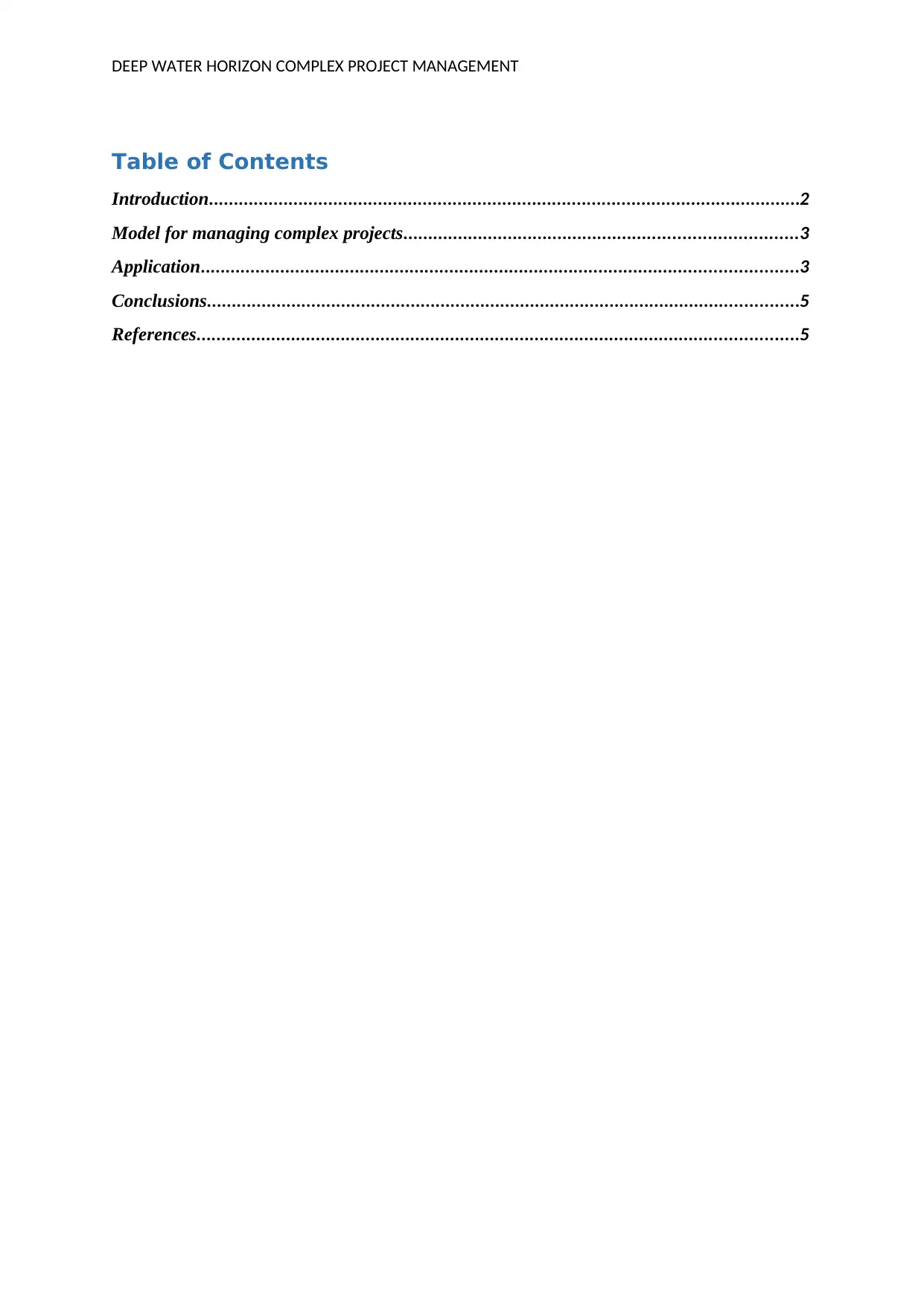
DEEP WATER HORIZON COMPLEX PROJECT MANAGEMENT
Table of Contents
Introduction.......................................................................................................................2
Model for managing complex projects...............................................................................3
Application........................................................................................................................3
Conclusions.......................................................................................................................5
References.........................................................................................................................5
Table of Contents
Introduction.......................................................................................................................2
Model for managing complex projects...............................................................................3
Application........................................................................................................................3
Conclusions.......................................................................................................................5
References.........................................................................................................................5
Paraphrase This Document
Need a fresh take? Get an instant paraphrase of this document with our AI Paraphraser
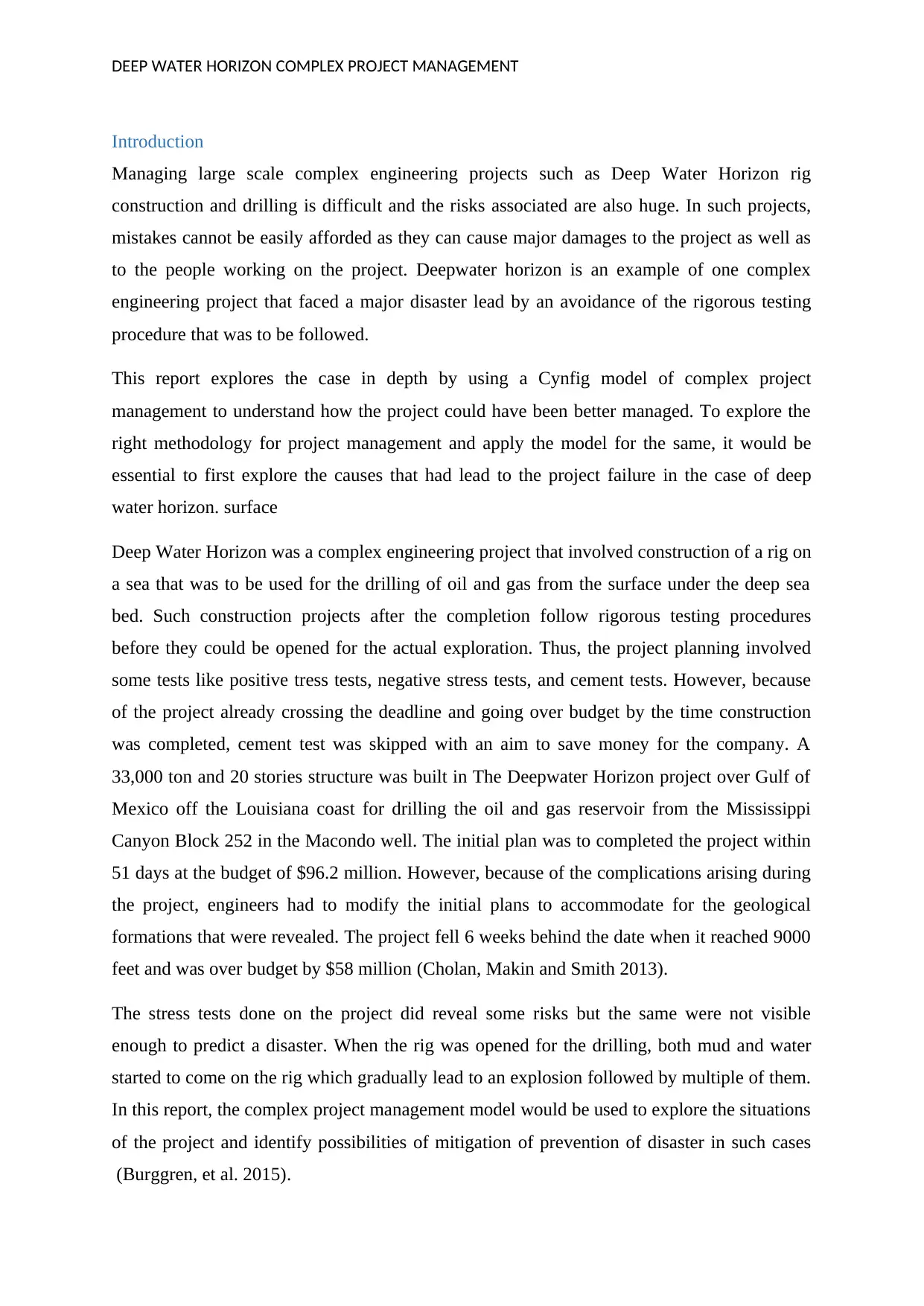
DEEP WATER HORIZON COMPLEX PROJECT MANAGEMENT
Introduction
Managing large scale complex engineering projects such as Deep Water Horizon rig
construction and drilling is difficult and the risks associated are also huge. In such projects,
mistakes cannot be easily afforded as they can cause major damages to the project as well as
to the people working on the project. Deepwater horizon is an example of one complex
engineering project that faced a major disaster lead by an avoidance of the rigorous testing
procedure that was to be followed.
This report explores the case in depth by using a Cynfig model of complex project
management to understand how the project could have been better managed. To explore the
right methodology for project management and apply the model for the same, it would be
essential to first explore the causes that had lead to the project failure in the case of deep
water horizon. surface
Deep Water Horizon was a complex engineering project that involved construction of a rig on
a sea that was to be used for the drilling of oil and gas from the surface under the deep sea
bed. Such construction projects after the completion follow rigorous testing procedures
before they could be opened for the actual exploration. Thus, the project planning involved
some tests like positive tress tests, negative stress tests, and cement tests. However, because
of the project already crossing the deadline and going over budget by the time construction
was completed, cement test was skipped with an aim to save money for the company. A
33,000 ton and 20 stories structure was built in The Deepwater Horizon project over Gulf of
Mexico off the Louisiana coast for drilling the oil and gas reservoir from the Mississippi
Canyon Block 252 in the Macondo well. The initial plan was to completed the project within
51 days at the budget of $96.2 million. However, because of the complications arising during
the project, engineers had to modify the initial plans to accommodate for the geological
formations that were revealed. The project fell 6 weeks behind the date when it reached 9000
feet and was over budget by $58 million (Cholan, Makin and Smith 2013).
The stress tests done on the project did reveal some risks but the same were not visible
enough to predict a disaster. When the rig was opened for the drilling, both mud and water
started to come on the rig which gradually lead to an explosion followed by multiple of them.
In this report, the complex project management model would be used to explore the situations
of the project and identify possibilities of mitigation of prevention of disaster in such cases
(Burggren, et al. 2015).
Introduction
Managing large scale complex engineering projects such as Deep Water Horizon rig
construction and drilling is difficult and the risks associated are also huge. In such projects,
mistakes cannot be easily afforded as they can cause major damages to the project as well as
to the people working on the project. Deepwater horizon is an example of one complex
engineering project that faced a major disaster lead by an avoidance of the rigorous testing
procedure that was to be followed.
This report explores the case in depth by using a Cynfig model of complex project
management to understand how the project could have been better managed. To explore the
right methodology for project management and apply the model for the same, it would be
essential to first explore the causes that had lead to the project failure in the case of deep
water horizon. surface
Deep Water Horizon was a complex engineering project that involved construction of a rig on
a sea that was to be used for the drilling of oil and gas from the surface under the deep sea
bed. Such construction projects after the completion follow rigorous testing procedures
before they could be opened for the actual exploration. Thus, the project planning involved
some tests like positive tress tests, negative stress tests, and cement tests. However, because
of the project already crossing the deadline and going over budget by the time construction
was completed, cement test was skipped with an aim to save money for the company. A
33,000 ton and 20 stories structure was built in The Deepwater Horizon project over Gulf of
Mexico off the Louisiana coast for drilling the oil and gas reservoir from the Mississippi
Canyon Block 252 in the Macondo well. The initial plan was to completed the project within
51 days at the budget of $96.2 million. However, because of the complications arising during
the project, engineers had to modify the initial plans to accommodate for the geological
formations that were revealed. The project fell 6 weeks behind the date when it reached 9000
feet and was over budget by $58 million (Cholan, Makin and Smith 2013).
The stress tests done on the project did reveal some risks but the same were not visible
enough to predict a disaster. When the rig was opened for the drilling, both mud and water
started to come on the rig which gradually lead to an explosion followed by multiple of them.
In this report, the complex project management model would be used to explore the situations
of the project and identify possibilities of mitigation of prevention of disaster in such cases
(Burggren, et al. 2015).
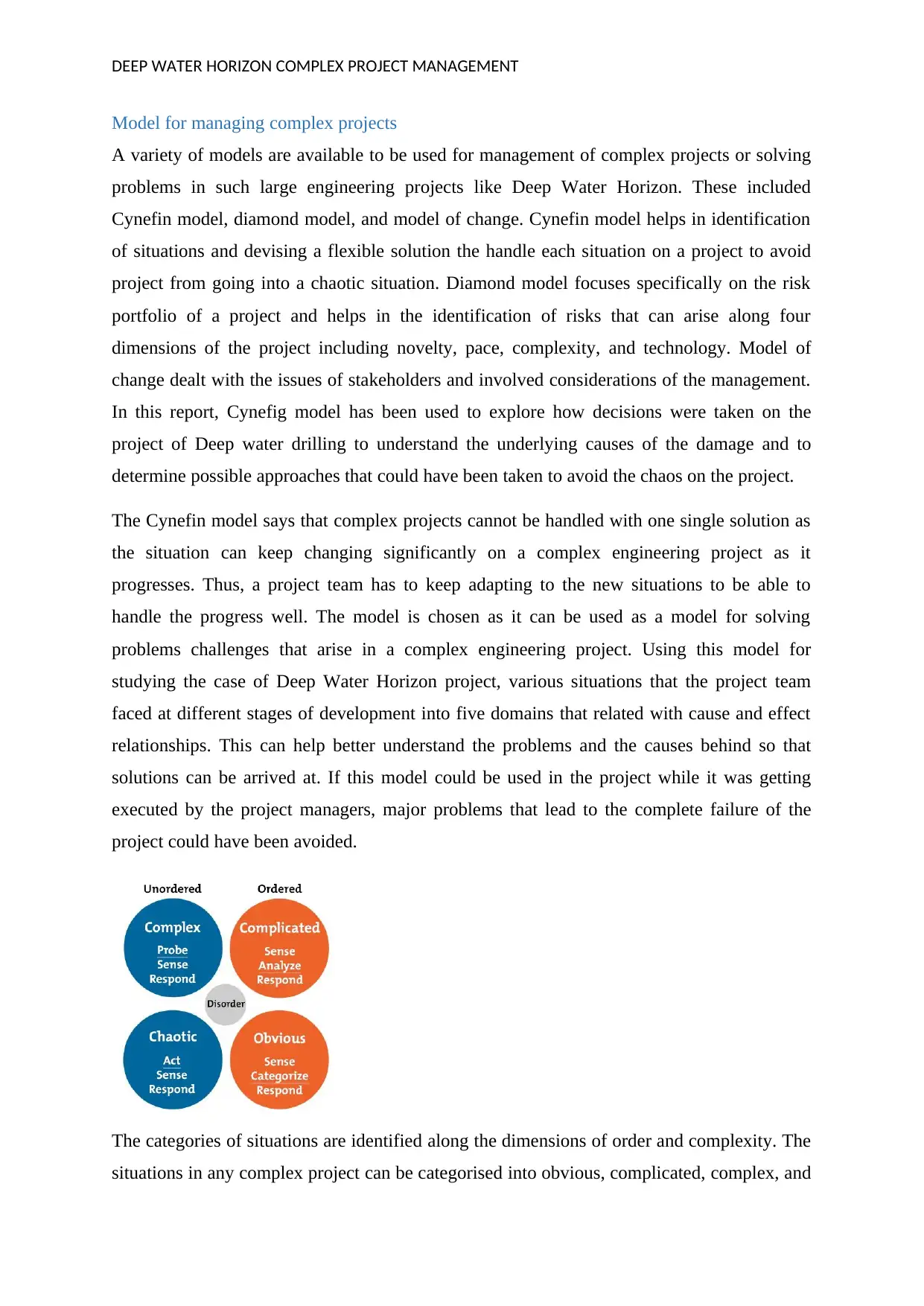
DEEP WATER HORIZON COMPLEX PROJECT MANAGEMENT
Model for managing complex projects
A variety of models are available to be used for management of complex projects or solving
problems in such large engineering projects like Deep Water Horizon. These included
Cynefin model, diamond model, and model of change. Cynefin model helps in identification
of situations and devising a flexible solution the handle each situation on a project to avoid
project from going into a chaotic situation. Diamond model focuses specifically on the risk
portfolio of a project and helps in the identification of risks that can arise along four
dimensions of the project including novelty, pace, complexity, and technology. Model of
change dealt with the issues of stakeholders and involved considerations of the management.
In this report, Cynefig model has been used to explore how decisions were taken on the
project of Deep water drilling to understand the underlying causes of the damage and to
determine possible approaches that could have been taken to avoid the chaos on the project.
The Cynefin model says that complex projects cannot be handled with one single solution as
the situation can keep changing significantly on a complex engineering project as it
progresses. Thus, a project team has to keep adapting to the new situations to be able to
handle the progress well. The model is chosen as it can be used as a model for solving
problems challenges that arise in a complex engineering project. Using this model for
studying the case of Deep Water Horizon project, various situations that the project team
faced at different stages of development into five domains that related with cause and effect
relationships. This can help better understand the problems and the causes behind so that
solutions can be arrived at. If this model could be used in the project while it was getting
executed by the project managers, major problems that lead to the complete failure of the
project could have been avoided.
The categories of situations are identified along the dimensions of order and complexity. The
situations in any complex project can be categorised into obvious, complicated, complex, and
Model for managing complex projects
A variety of models are available to be used for management of complex projects or solving
problems in such large engineering projects like Deep Water Horizon. These included
Cynefin model, diamond model, and model of change. Cynefin model helps in identification
of situations and devising a flexible solution the handle each situation on a project to avoid
project from going into a chaotic situation. Diamond model focuses specifically on the risk
portfolio of a project and helps in the identification of risks that can arise along four
dimensions of the project including novelty, pace, complexity, and technology. Model of
change dealt with the issues of stakeholders and involved considerations of the management.
In this report, Cynefig model has been used to explore how decisions were taken on the
project of Deep water drilling to understand the underlying causes of the damage and to
determine possible approaches that could have been taken to avoid the chaos on the project.
The Cynefin model says that complex projects cannot be handled with one single solution as
the situation can keep changing significantly on a complex engineering project as it
progresses. Thus, a project team has to keep adapting to the new situations to be able to
handle the progress well. The model is chosen as it can be used as a model for solving
problems challenges that arise in a complex engineering project. Using this model for
studying the case of Deep Water Horizon project, various situations that the project team
faced at different stages of development into five domains that related with cause and effect
relationships. This can help better understand the problems and the causes behind so that
solutions can be arrived at. If this model could be used in the project while it was getting
executed by the project managers, major problems that lead to the complete failure of the
project could have been avoided.
The categories of situations are identified along the dimensions of order and complexity. The
situations in any complex project can be categorised into obvious, complicated, complex, and
⊘ This is a preview!⊘
Do you want full access?
Subscribe today to unlock all pages.

Trusted by 1+ million students worldwide
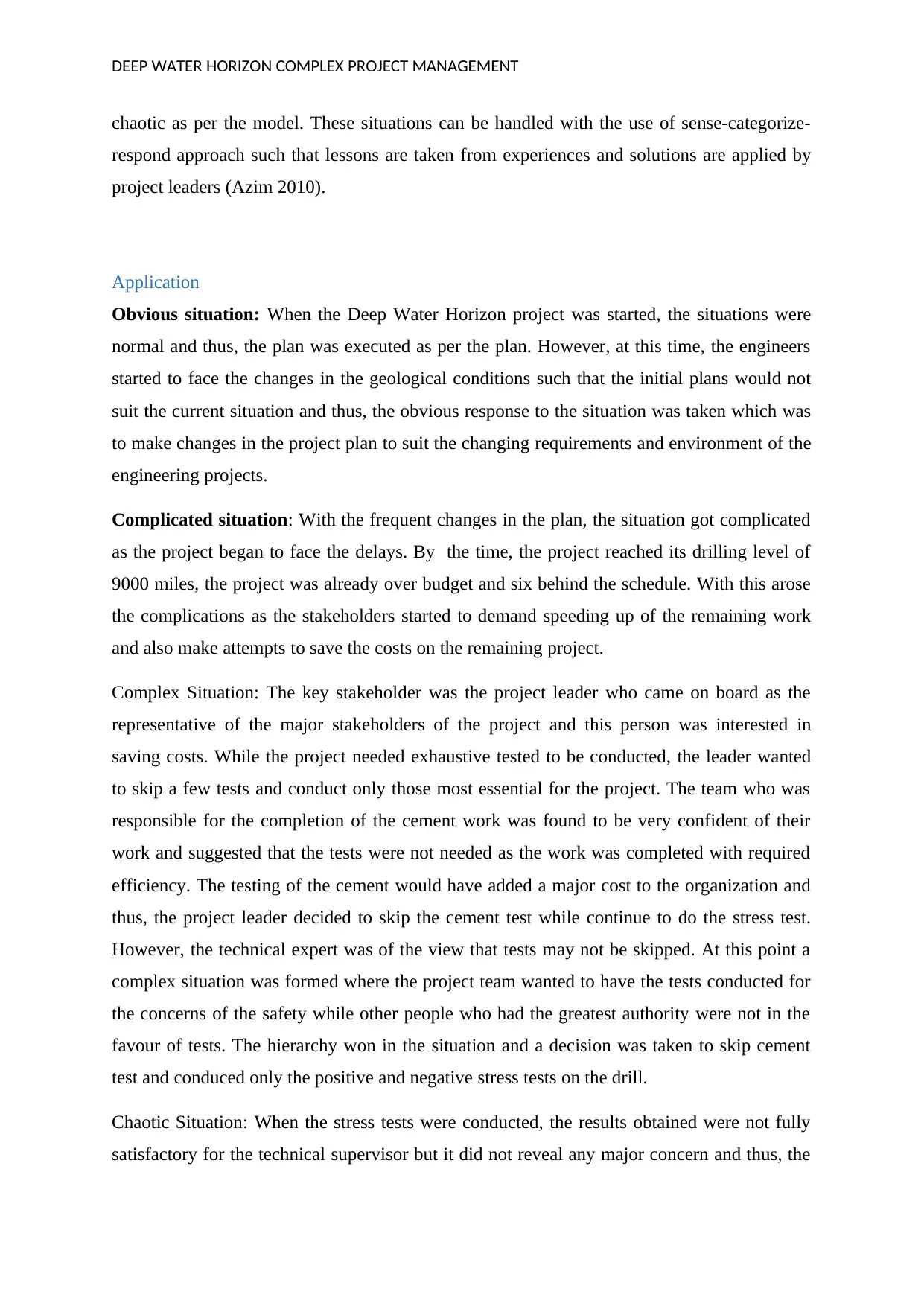
DEEP WATER HORIZON COMPLEX PROJECT MANAGEMENT
chaotic as per the model. These situations can be handled with the use of sense-categorize-
respond approach such that lessons are taken from experiences and solutions are applied by
project leaders (Azim 2010).
Application
Obvious situation: When the Deep Water Horizon project was started, the situations were
normal and thus, the plan was executed as per the plan. However, at this time, the engineers
started to face the changes in the geological conditions such that the initial plans would not
suit the current situation and thus, the obvious response to the situation was taken which was
to make changes in the project plan to suit the changing requirements and environment of the
engineering projects.
Complicated situation: With the frequent changes in the plan, the situation got complicated
as the project began to face the delays. By the time, the project reached its drilling level of
9000 miles, the project was already over budget and six behind the schedule. With this arose
the complications as the stakeholders started to demand speeding up of the remaining work
and also make attempts to save the costs on the remaining project.
Complex Situation: The key stakeholder was the project leader who came on board as the
representative of the major stakeholders of the project and this person was interested in
saving costs. While the project needed exhaustive tested to be conducted, the leader wanted
to skip a few tests and conduct only those most essential for the project. The team who was
responsible for the completion of the cement work was found to be very confident of their
work and suggested that the tests were not needed as the work was completed with required
efficiency. The testing of the cement would have added a major cost to the organization and
thus, the project leader decided to skip the cement test while continue to do the stress test.
However, the technical expert was of the view that tests may not be skipped. At this point a
complex situation was formed where the project team wanted to have the tests conducted for
the concerns of the safety while other people who had the greatest authority were not in the
favour of tests. The hierarchy won in the situation and a decision was taken to skip cement
test and conduced only the positive and negative stress tests on the drill.
Chaotic Situation: When the stress tests were conducted, the results obtained were not fully
satisfactory for the technical supervisor but it did not reveal any major concern and thus, the
chaotic as per the model. These situations can be handled with the use of sense-categorize-
respond approach such that lessons are taken from experiences and solutions are applied by
project leaders (Azim 2010).
Application
Obvious situation: When the Deep Water Horizon project was started, the situations were
normal and thus, the plan was executed as per the plan. However, at this time, the engineers
started to face the changes in the geological conditions such that the initial plans would not
suit the current situation and thus, the obvious response to the situation was taken which was
to make changes in the project plan to suit the changing requirements and environment of the
engineering projects.
Complicated situation: With the frequent changes in the plan, the situation got complicated
as the project began to face the delays. By the time, the project reached its drilling level of
9000 miles, the project was already over budget and six behind the schedule. With this arose
the complications as the stakeholders started to demand speeding up of the remaining work
and also make attempts to save the costs on the remaining project.
Complex Situation: The key stakeholder was the project leader who came on board as the
representative of the major stakeholders of the project and this person was interested in
saving costs. While the project needed exhaustive tested to be conducted, the leader wanted
to skip a few tests and conduct only those most essential for the project. The team who was
responsible for the completion of the cement work was found to be very confident of their
work and suggested that the tests were not needed as the work was completed with required
efficiency. The testing of the cement would have added a major cost to the organization and
thus, the project leader decided to skip the cement test while continue to do the stress test.
However, the technical expert was of the view that tests may not be skipped. At this point a
complex situation was formed where the project team wanted to have the tests conducted for
the concerns of the safety while other people who had the greatest authority were not in the
favour of tests. The hierarchy won in the situation and a decision was taken to skip cement
test and conduced only the positive and negative stress tests on the drill.
Chaotic Situation: When the stress tests were conducted, the results obtained were not fully
satisfactory for the technical supervisor but it did not reveal any major concern and thus, the
Paraphrase This Document
Need a fresh take? Get an instant paraphrase of this document with our AI Paraphraser

DEEP WATER HORIZON COMPLEX PROJECT MANAGEMENT
team decided to continue with the drilling. As the drilling work started, the situation got
chaotic. At this point, both mud and water started to gush out and spill over the rig. Before
the situation could be understood, the mud started to blow the rig and spilled all over the
place. At this point, a decision could have been taken to call for the emergency to control the
chaotic situation but because of the lack of the authority with the person in the drill, the
emergency was not called and the team was asked to take efforts to stop the mud from
coming by closing down the drill. However, before it could be done, it was late and the gas
started to blow out causing a fire on the rig.
Complete Chaos: With the break of the fire, the situation went totally chaotic as the fire
started to catch up to the vulnerable areas which resulted several blasts. At this point, the
team started to act assessing the emergency and was asked too vacate the rig before
everything would blew up (Sperling 2015).
When considering the model, the situations could have been handled on the basis of the cause
and effect relationships analysis using the “sense-analyse-respond” approach. In the
complicated situation, the danger of missing out of the safety of the rig could have been
sensed in which case, the tests that were to be conducted on the cement work would not be
skipped.
Going to the complex situation when Mike could not find the zero value to get the true test in
the pressure test, the model could be used to reflect upon the cause and effect relationship to
identify issues that could have caused this variation. Considering the model, the variation
would not have allowed the team to proceeded with the project but instead, more tests could
have been conducted to verify the situation before the team would move ahead to start the
drilling of the well. Although, the decision was taken to re-run the stress test for confirmation
of the safety, Mike was still not satisfied with the readings and a decision was needed to stop
the project progress and do something about the identified issue. This could have helped the
project manager determine the actual cause behind variations in the reading and take
necessary steps for the enhancement of the safety of the rig.
However, when the complex situation was not responded to correctly, the situation became
chaotic and the mud as well as water started to blow up on the rig along with the oil and gas.
In the situation which is chaotic, a fast response like emergency plan execution towards
safety of workers could have been executed with the guidance from the model before the
situation became chaotic. At this point, the project leader could have taken a decision to
team decided to continue with the drilling. As the drilling work started, the situation got
chaotic. At this point, both mud and water started to gush out and spill over the rig. Before
the situation could be understood, the mud started to blow the rig and spilled all over the
place. At this point, a decision could have been taken to call for the emergency to control the
chaotic situation but because of the lack of the authority with the person in the drill, the
emergency was not called and the team was asked to take efforts to stop the mud from
coming by closing down the drill. However, before it could be done, it was late and the gas
started to blow out causing a fire on the rig.
Complete Chaos: With the break of the fire, the situation went totally chaotic as the fire
started to catch up to the vulnerable areas which resulted several blasts. At this point, the
team started to act assessing the emergency and was asked too vacate the rig before
everything would blew up (Sperling 2015).
When considering the model, the situations could have been handled on the basis of the cause
and effect relationships analysis using the “sense-analyse-respond” approach. In the
complicated situation, the danger of missing out of the safety of the rig could have been
sensed in which case, the tests that were to be conducted on the cement work would not be
skipped.
Going to the complex situation when Mike could not find the zero value to get the true test in
the pressure test, the model could be used to reflect upon the cause and effect relationship to
identify issues that could have caused this variation. Considering the model, the variation
would not have allowed the team to proceeded with the project but instead, more tests could
have been conducted to verify the situation before the team would move ahead to start the
drilling of the well. Although, the decision was taken to re-run the stress test for confirmation
of the safety, Mike was still not satisfied with the readings and a decision was needed to stop
the project progress and do something about the identified issue. This could have helped the
project manager determine the actual cause behind variations in the reading and take
necessary steps for the enhancement of the safety of the rig.
However, when the complex situation was not responded to correctly, the situation became
chaotic and the mud as well as water started to blow up on the rig along with the oil and gas.
In the situation which is chaotic, a fast response like emergency plan execution towards
safety of workers could have been executed with the guidance from the model before the
situation became chaotic. At this point, the project leader could have taken a decision to
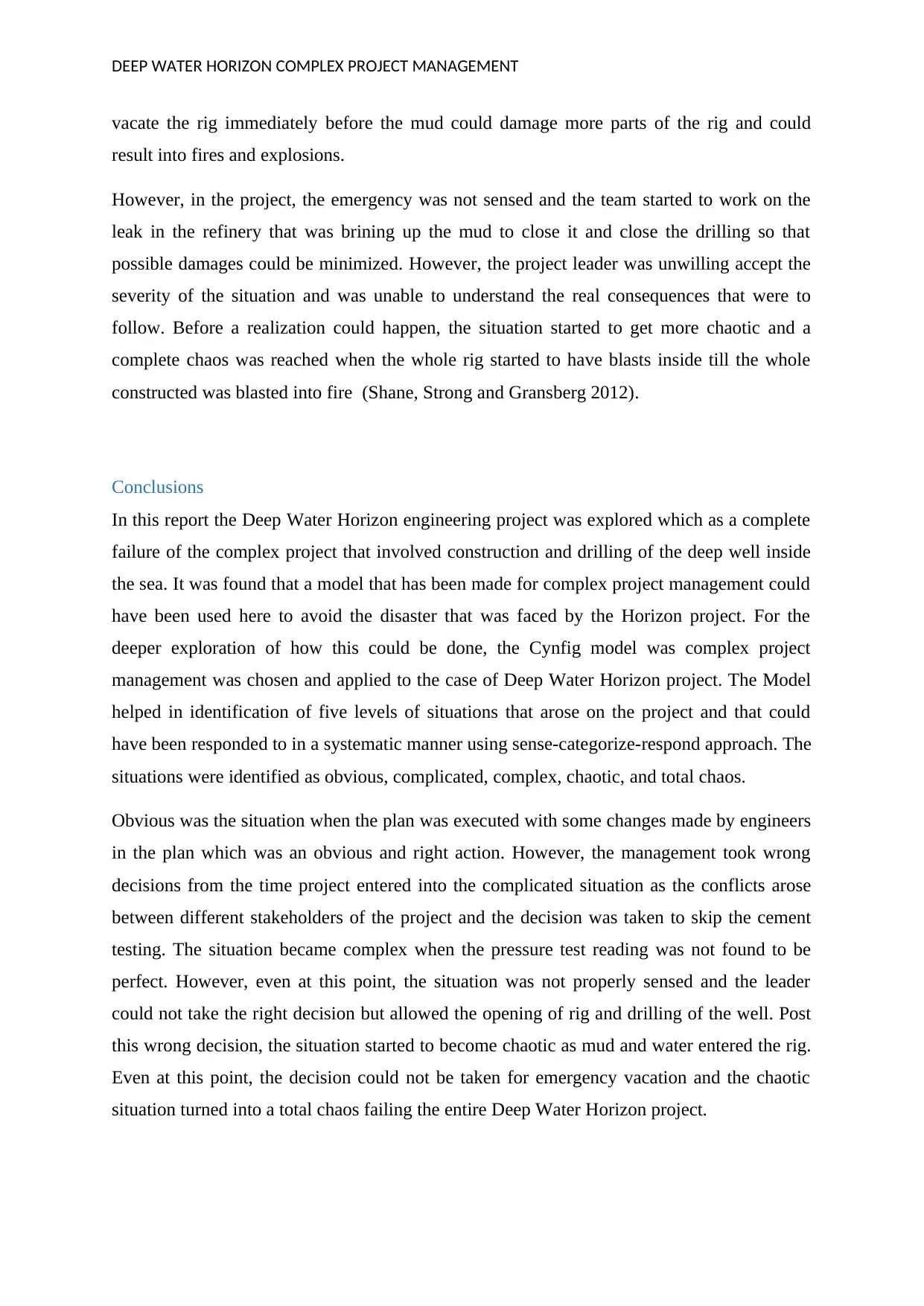
DEEP WATER HORIZON COMPLEX PROJECT MANAGEMENT
vacate the rig immediately before the mud could damage more parts of the rig and could
result into fires and explosions.
However, in the project, the emergency was not sensed and the team started to work on the
leak in the refinery that was brining up the mud to close it and close the drilling so that
possible damages could be minimized. However, the project leader was unwilling accept the
severity of the situation and was unable to understand the real consequences that were to
follow. Before a realization could happen, the situation started to get more chaotic and a
complete chaos was reached when the whole rig started to have blasts inside till the whole
constructed was blasted into fire (Shane, Strong and Gransberg 2012).
Conclusions
In this report the Deep Water Horizon engineering project was explored which as a complete
failure of the complex project that involved construction and drilling of the deep well inside
the sea. It was found that a model that has been made for complex project management could
have been used here to avoid the disaster that was faced by the Horizon project. For the
deeper exploration of how this could be done, the Cynfig model was complex project
management was chosen and applied to the case of Deep Water Horizon project. The Model
helped in identification of five levels of situations that arose on the project and that could
have been responded to in a systematic manner using sense-categorize-respond approach. The
situations were identified as obvious, complicated, complex, chaotic, and total chaos.
Obvious was the situation when the plan was executed with some changes made by engineers
in the plan which was an obvious and right action. However, the management took wrong
decisions from the time project entered into the complicated situation as the conflicts arose
between different stakeholders of the project and the decision was taken to skip the cement
testing. The situation became complex when the pressure test reading was not found to be
perfect. However, even at this point, the situation was not properly sensed and the leader
could not take the right decision but allowed the opening of rig and drilling of the well. Post
this wrong decision, the situation started to become chaotic as mud and water entered the rig.
Even at this point, the decision could not be taken for emergency vacation and the chaotic
situation turned into a total chaos failing the entire Deep Water Horizon project.
vacate the rig immediately before the mud could damage more parts of the rig and could
result into fires and explosions.
However, in the project, the emergency was not sensed and the team started to work on the
leak in the refinery that was brining up the mud to close it and close the drilling so that
possible damages could be minimized. However, the project leader was unwilling accept the
severity of the situation and was unable to understand the real consequences that were to
follow. Before a realization could happen, the situation started to get more chaotic and a
complete chaos was reached when the whole rig started to have blasts inside till the whole
constructed was blasted into fire (Shane, Strong and Gransberg 2012).
Conclusions
In this report the Deep Water Horizon engineering project was explored which as a complete
failure of the complex project that involved construction and drilling of the deep well inside
the sea. It was found that a model that has been made for complex project management could
have been used here to avoid the disaster that was faced by the Horizon project. For the
deeper exploration of how this could be done, the Cynfig model was complex project
management was chosen and applied to the case of Deep Water Horizon project. The Model
helped in identification of five levels of situations that arose on the project and that could
have been responded to in a systematic manner using sense-categorize-respond approach. The
situations were identified as obvious, complicated, complex, chaotic, and total chaos.
Obvious was the situation when the plan was executed with some changes made by engineers
in the plan which was an obvious and right action. However, the management took wrong
decisions from the time project entered into the complicated situation as the conflicts arose
between different stakeholders of the project and the decision was taken to skip the cement
testing. The situation became complex when the pressure test reading was not found to be
perfect. However, even at this point, the situation was not properly sensed and the leader
could not take the right decision but allowed the opening of rig and drilling of the well. Post
this wrong decision, the situation started to become chaotic as mud and water entered the rig.
Even at this point, the decision could not be taken for emergency vacation and the chaotic
situation turned into a total chaos failing the entire Deep Water Horizon project.
⊘ This is a preview!⊘
Do you want full access?
Subscribe today to unlock all pages.

Trusted by 1+ million students worldwide
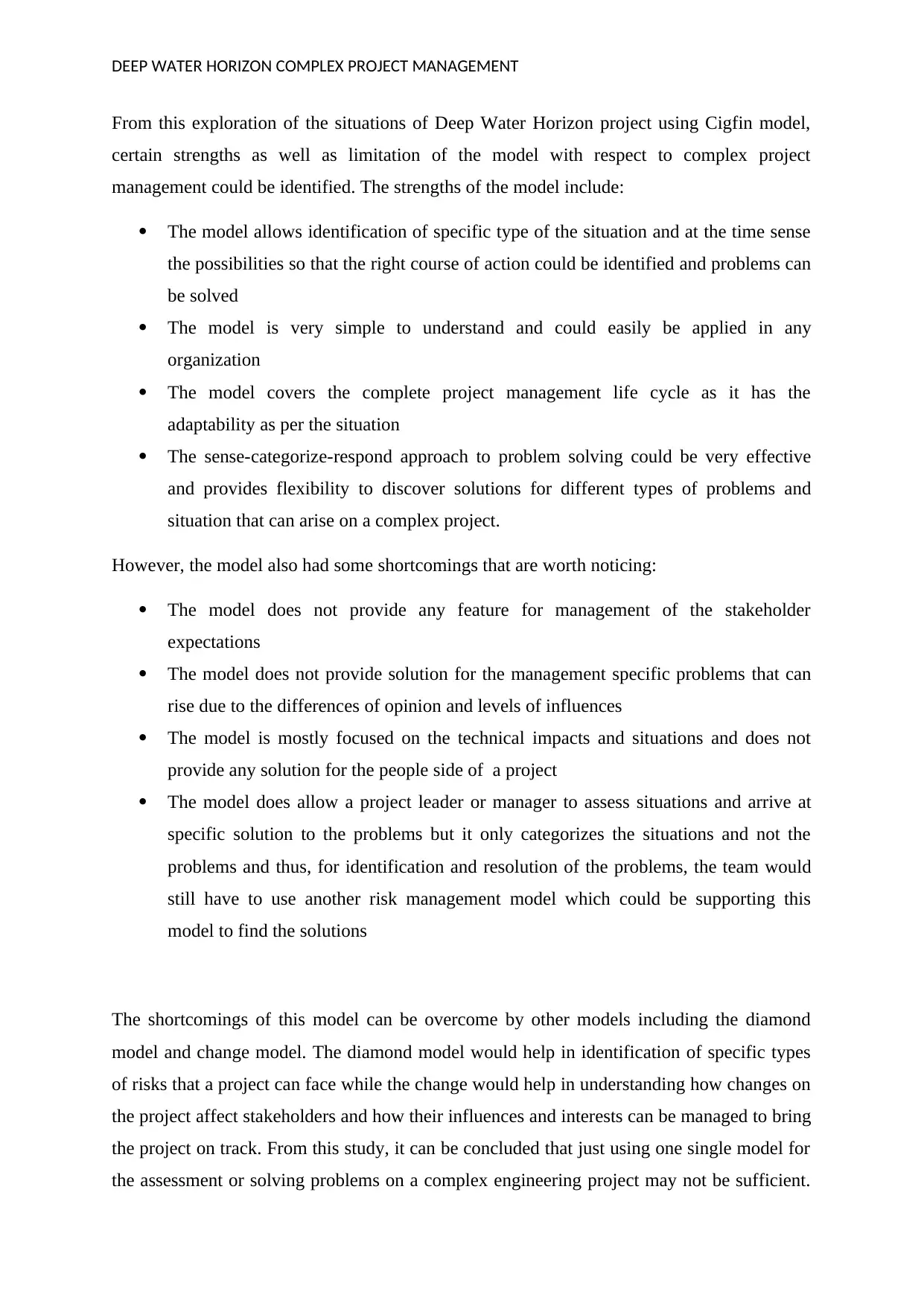
DEEP WATER HORIZON COMPLEX PROJECT MANAGEMENT
From this exploration of the situations of Deep Water Horizon project using Cigfin model,
certain strengths as well as limitation of the model with respect to complex project
management could be identified. The strengths of the model include:
The model allows identification of specific type of the situation and at the time sense
the possibilities so that the right course of action could be identified and problems can
be solved
The model is very simple to understand and could easily be applied in any
organization
The model covers the complete project management life cycle as it has the
adaptability as per the situation
The sense-categorize-respond approach to problem solving could be very effective
and provides flexibility to discover solutions for different types of problems and
situation that can arise on a complex project.
However, the model also had some shortcomings that are worth noticing:
The model does not provide any feature for management of the stakeholder
expectations
The model does not provide solution for the management specific problems that can
rise due to the differences of opinion and levels of influences
The model is mostly focused on the technical impacts and situations and does not
provide any solution for the people side of a project
The model does allow a project leader or manager to assess situations and arrive at
specific solution to the problems but it only categorizes the situations and not the
problems and thus, for identification and resolution of the problems, the team would
still have to use another risk management model which could be supporting this
model to find the solutions
The shortcomings of this model can be overcome by other models including the diamond
model and change model. The diamond model would help in identification of specific types
of risks that a project can face while the change would help in understanding how changes on
the project affect stakeholders and how their influences and interests can be managed to bring
the project on track. From this study, it can be concluded that just using one single model for
the assessment or solving problems on a complex engineering project may not be sufficient.
From this exploration of the situations of Deep Water Horizon project using Cigfin model,
certain strengths as well as limitation of the model with respect to complex project
management could be identified. The strengths of the model include:
The model allows identification of specific type of the situation and at the time sense
the possibilities so that the right course of action could be identified and problems can
be solved
The model is very simple to understand and could easily be applied in any
organization
The model covers the complete project management life cycle as it has the
adaptability as per the situation
The sense-categorize-respond approach to problem solving could be very effective
and provides flexibility to discover solutions for different types of problems and
situation that can arise on a complex project.
However, the model also had some shortcomings that are worth noticing:
The model does not provide any feature for management of the stakeholder
expectations
The model does not provide solution for the management specific problems that can
rise due to the differences of opinion and levels of influences
The model is mostly focused on the technical impacts and situations and does not
provide any solution for the people side of a project
The model does allow a project leader or manager to assess situations and arrive at
specific solution to the problems but it only categorizes the situations and not the
problems and thus, for identification and resolution of the problems, the team would
still have to use another risk management model which could be supporting this
model to find the solutions
The shortcomings of this model can be overcome by other models including the diamond
model and change model. The diamond model would help in identification of specific types
of risks that a project can face while the change would help in understanding how changes on
the project affect stakeholders and how their influences and interests can be managed to bring
the project on track. From this study, it can be concluded that just using one single model for
the assessment or solving problems on a complex engineering project may not be sufficient.
Paraphrase This Document
Need a fresh take? Get an instant paraphrase of this document with our AI Paraphraser

DEEP WATER HORIZON COMPLEX PROJECT MANAGEMENT
Instead, the project would need the use of the combination of different approaches defined in
these models so that a comprehensive view can be seen. While the first model would identify
the situation, the diamond model would help in identification of specific risks in those
situations and the change model would provide solution involving people or stakeholders on
the project.
References
Azim, Syed Waqar. 2010. Understanding and Managing Project Complexity . School of
Mechanical, Aerospace and Civil Engineering .
Burggren, Warren, Benjamin Dubansky, Aaron Roberts, and Matthew Alloy. 2015.
“Deepwater Horizon Oil Spill as a Case Study for Interdisciplinary Cooperation
within Developmental Biology, Environmental Sciences and Physiology.” World
Journal of Engineering and Technology 7-23.
Cholan, Jothika, Tyler Makin, and Samantha Smith. 2013. The Deepwater Horizon Oil Spill
A Case Study about the Development of an Evolving Communication Strategy.
Marshall School of Business.
Shane, Jennifer, Kelly Strong, and Douglas Gransberg. 2012. Guidebook: Project
Management Strategies for Complex Projects. National Academy of Sciences.
Sperling, Daneil. 2015. Guide to Project Management Strategies for Complex Projects.
TRANSPORTATION RESEARCH BOARD.
Instead, the project would need the use of the combination of different approaches defined in
these models so that a comprehensive view can be seen. While the first model would identify
the situation, the diamond model would help in identification of specific risks in those
situations and the change model would provide solution involving people or stakeholders on
the project.
References
Azim, Syed Waqar. 2010. Understanding and Managing Project Complexity . School of
Mechanical, Aerospace and Civil Engineering .
Burggren, Warren, Benjamin Dubansky, Aaron Roberts, and Matthew Alloy. 2015.
“Deepwater Horizon Oil Spill as a Case Study for Interdisciplinary Cooperation
within Developmental Biology, Environmental Sciences and Physiology.” World
Journal of Engineering and Technology 7-23.
Cholan, Jothika, Tyler Makin, and Samantha Smith. 2013. The Deepwater Horizon Oil Spill
A Case Study about the Development of an Evolving Communication Strategy.
Marshall School of Business.
Shane, Jennifer, Kelly Strong, and Douglas Gransberg. 2012. Guidebook: Project
Management Strategies for Complex Projects. National Academy of Sciences.
Sperling, Daneil. 2015. Guide to Project Management Strategies for Complex Projects.
TRANSPORTATION RESEARCH BOARD.
1 out of 8
Related Documents
Your All-in-One AI-Powered Toolkit for Academic Success.
+13062052269
info@desklib.com
Available 24*7 on WhatsApp / Email
![[object Object]](/_next/static/media/star-bottom.7253800d.svg)
Unlock your academic potential
Copyright © 2020–2025 A2Z Services. All Rights Reserved. Developed and managed by ZUCOL.




